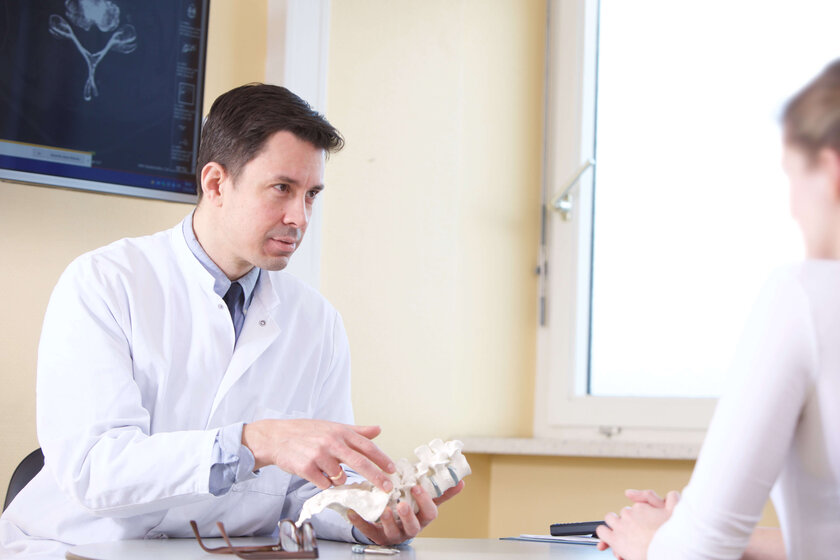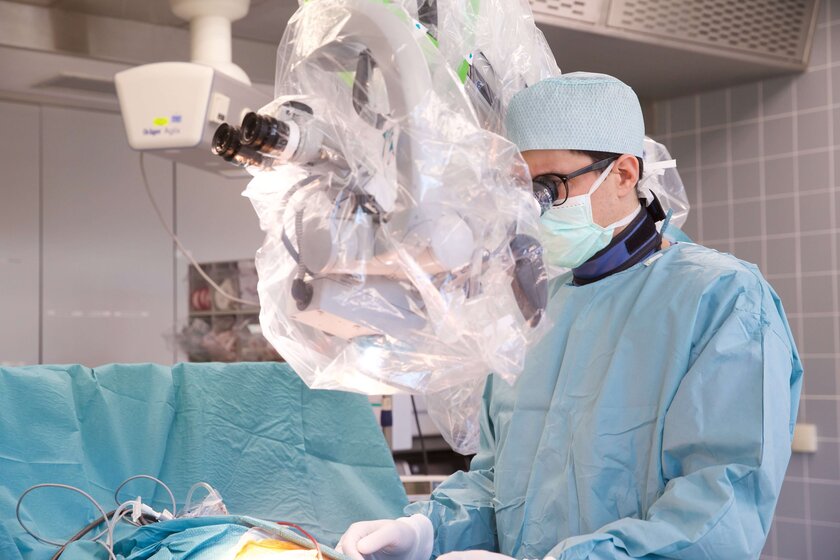Spine surgery services
The spine
The spine is the central organ of movement. In order to meet the numerous demands, a balance must be struck everyday between mobility and flexibility on the one hand, and stability and power transmission on the other. These processes cost energy and their use lead to slow wear and tear of the anatomical structures involved such as, bones, joints, cartilage, muscles and tendons.
In addition, the spine contains and protects our inner "cable", the spinal cord, which feeds back all important information from our body to our brain and carries the information from the brain into the body.
As a result of the close anatomical relationship between the nerve tissue and the spine, there may be both localised problems in the area of the spine (e.g. deep, stabbing back pain from osteoarthritis of the small vertebral joint or from wear and tear and leaking fluid caused by vertebral slip) and often excruciating back pain and radiating pain in the leg, which is caused by pressure placed on the nerves that exit the spine.
Due to natural wear and tear with increasing age or enormous strain on the spine, more and more people suffer from back pain. It is completely normal to have back, neck or shoulder pain from time to time. These problems are often unspecific and usually harmless. About 85 percent of back pain will most likely go away after a few days or weeks.
However, it is not uncommon for the pain to be relatively strong, increase more and more or lead to neurological abnormalities such as numbness or paralysis. These complaints are not unspecific, but usually have clearly identifiable and diagnosable causes, especially if the pain occurs in the arms or legs (e.g., herniated disc/slipped disc, spinal stenosis, spondylolisthesis).
Our goal is to take the appropriate steps together with you and your primary care providers (general practitioner, orthopaedist, neurologist ...) so that your spine can continue to provide the necessary support in your life.
Our services
- Herniated disc/slipped disc (Cervical and Lumbar Spine)
- Spinal stenosis (Cervical and Lumbar Spine)
- Neural Foraminal Stenosis/nerve constriction (Cervical and Lumbar Spine)
- Other degenerative diseases
- Arthrosis of the spine
- Spondylolisthesis/ slipped vertebrae
- Spinal instability
- Kyphosis
- Degenerative scoliosis/ "crooked" spine
- ISG syndrome
- Oncological diseases
- Spinal metastases
- Spinal tumours, spinal cord tumours, nerve root
- Fractured vertebrae bodies/ fractured spine
- Osteoporosis-related fractures/ vertebral fractures
- Tumour-related fractures/ vertebral fractures
- Fall-related fractures/ vertebrae fractures
- Rare diseases
- Tarlov cysts
- Spinal arteriovenous fistulas
- Cerebrospinal fluid hypotension syndrome/ intracranial hypotension
Modern methods
We use numerous modern technologies, such as surgical microscopes or intraoperative neurophysiological monitoring.
All operations are performed under the operating microscope, e.g., for minimally invasive therapy of herniated discs/slipped discs and narrowing of the spinal canal.
Intraoperative 3D X-ray analysis: this CT-like procedure, allows the position of implants to be checked during the operation and the correction of mispositions to be verified with a fraction of the radiation of a CT scan.
Cementable cannulated screws: increase the anchorage stability of implants in osteoporosis and reduce the risk of cementation.
Use of bone substitutes in spinal fusions.
Intraoperative neuromonitoring: Enables the monitoring of nerve function during surgery.


